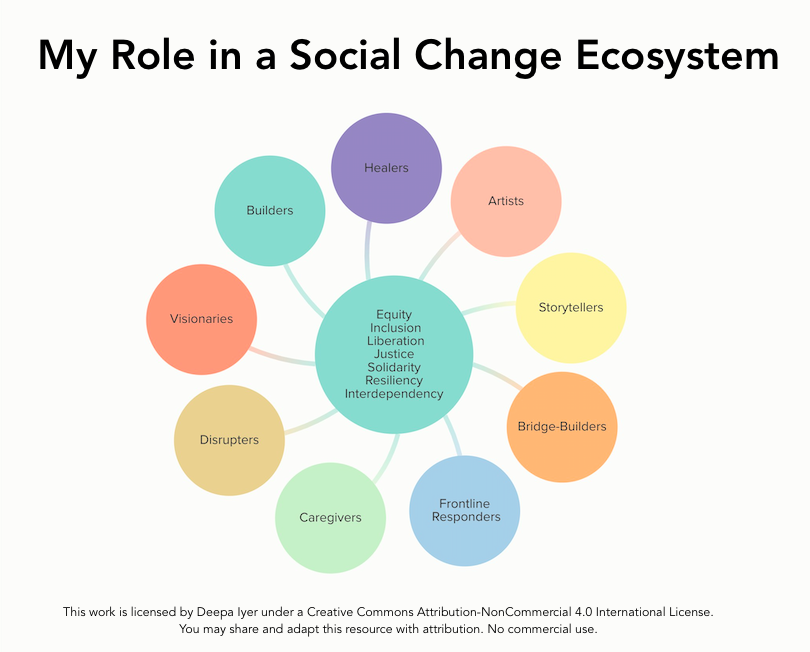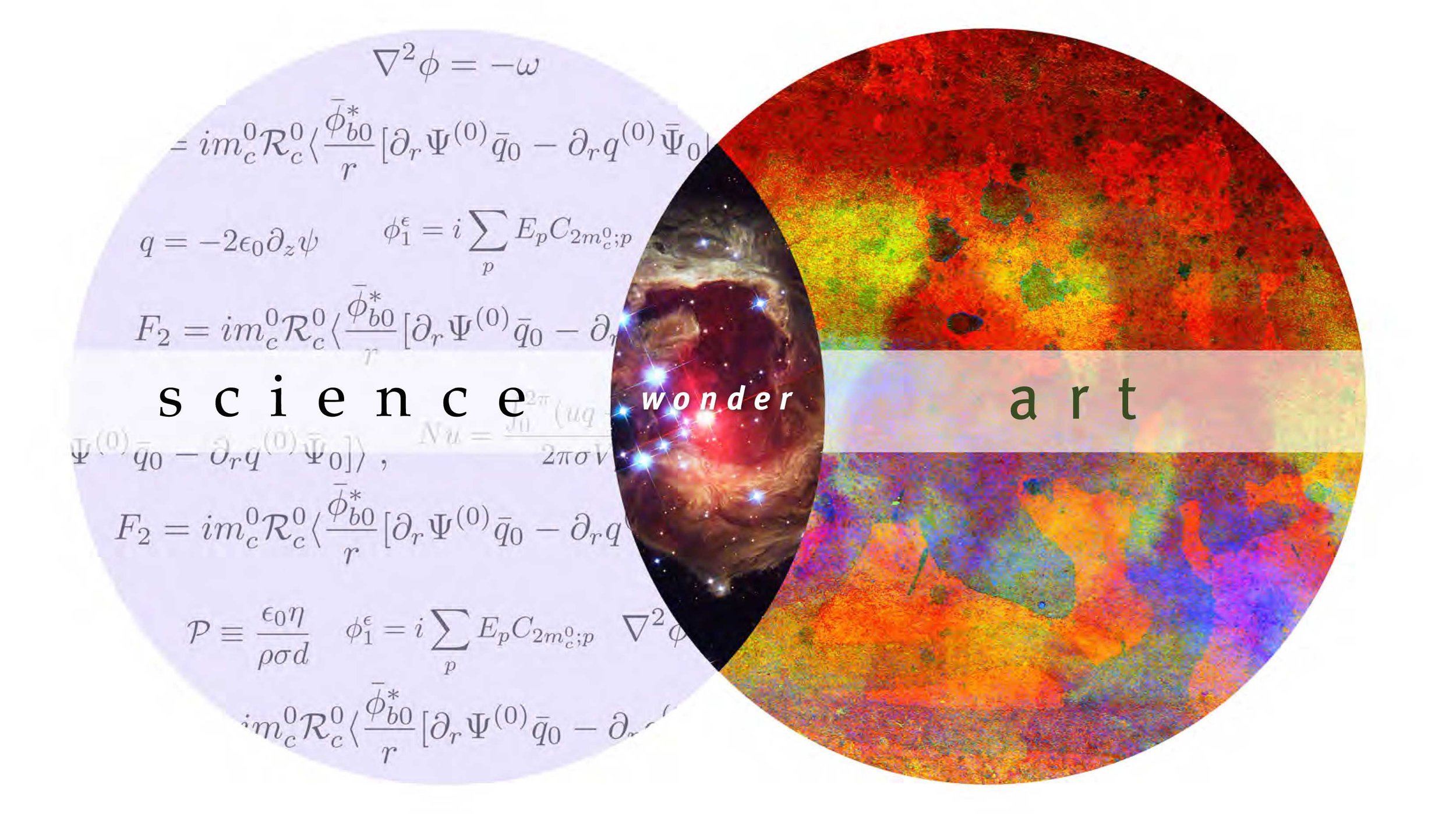designing at the intersection of thinking as an artist and scientist
Art and science are often seen as opposites. When I was applying to university, I struggled to choose between the Faculty of Arts, Commerce, or Sciences. As a writer, poet, and painter, I was drawn to the arts, where emotion, creative expression, and storytelling shaped how I made sense of the world. At the same time, my analytical side valued data-informed thinking and the objectivity that comes from testing, experimenting, and learning. I ended up taking courses across multiple disciplines, spending time in both studios and labs. What I found is that both fields demand deep curiosity, imagination, and the boldness to ask, “Is it possible?” or “Wouldn’t it be cool if?”
In the world of social change and systems work, there’s no single path in. People come from everywhere; law, social work, community organizing, communications, education, health care, business. Many carry lived experience that offers critical insight into the barriers others only study. These experiences often shape sharper questions, deeper empathy, and more grounded solutions. Whether learned in classrooms or forged in real life, all forms of knowledge matter. All disciplines are needed. Every voice is called on. Because creating lasting change takes all of us, and without any one of us, progress is fragile.
We all have a role to play in pursuit of equity, liberation, inclusion and justice. There is a framework by Deepa Iyer that illustrates various roles in an effective, healthy and sustainable social change ecosystem and it demands different actors to carry out these roles, at different times. This outlook resonates with my own. I believe meaningful progress accelerates when people across sectors share resources and champion inclusive decision-making within their spheres of influence. This kind of work is inherently interdependent, interdisciplinary, and rooted in diverse lived realities. I’m inspired by how it's breaking down silos, encouraging collective leadership, and showing how open-source knowledge can lead to more resilient ideas and well-rounded solutions. There is so much we can learn from one another about building more cooperative, connected, and collaborative systems.
photo credits: Ontario Science CenterSince 2020, conversations about equity and inclusion have become more prominent in Corporate America, often framed as a function of Human Resources, something to navigate within the constraints of schedules, budgets, and operational frameworks. But meaningful change requires a different kind of mindset. It asks us to think less like entrepreneurs focused solely on efficiency, and more like artists and scientists, tapping into creativity, curiosity, and play. This shift opens up space to imagine and build systems that are not just better, but radically more just, expansive, and liberatory.
When we think like artists, we embrace the messy, imperfect, and unstructured. We connect ideas, feel deeply, and grow more comfortable with ambiguity. Humans are multi-faceted and fluid and the challenges we face today are just as complex. Issues like inequality and injustice are deeply rooted in overlapping social, economic, and environmental systems. To meaningfully engage with them, we need to take a wide-angle view of the full picture while also zooming in to notice every detail, each brushstroke, each texture, and understand how the pieces come together to shape broader outcomes.
When we think like scientists, we begin with big, exploratory questions. We observe carefully, challenge assumptions, and stay open to learning. Scientific thinking calls us to seek truth, even when it’s uncomfortable to revise what we believe in light of new information, and to ask difficult questions, especially when they go against the grain. This kind of truth-seeking often comes with resistance. Those who challenge entrenched systems may face consequences, social, professional, or economic, for refusing to stay silent. And yet, like scientists who continue to sound the alarm on climate change or public health, there are leaders and advocates who persist in raising uncomfortable truths, even when others choose denial. Their work is a reminder that progress depends on courage, integrity, and an unwavering commitment to honesty.
This image/chart is not an exhaustive or definitive list. It represents some of the ways I see transformative work taking shape at the intersection of thinking, wondering, and creating drawing from both artistic and scientific mindsets. In the iconic words of Leonardo da Vinci: “Study the science of art. Study the art of science. Develop your senses learn how to see. Realize that everything connects to everything else.”
As we engage in systems thinking, we begin to understand how a change in one part of a system reverberates throughout the whole. Efforts to create more just and inclusive environments require us to examine the deep interconnections between struggles and to question the assumptions baked into how our institutions operate.
What if, instead of layering inclusion efforts onto existing structures, we reimagined how we build, research, design, and collaborate altogether? What if we approached complex challenges with more interdisciplinary tools combining data and empathy, creativity and analysis, structure and improvisation?
This isn’t just a shift for those formally trained in systems change or equity work it’s a call for anyone seeking to bring more humanity, fairness, and intentionality into their everyday roles. The skills needed may already be within reach, rooted in how we think, create, and connect in our work. The invitation is to lean into them and to do what you do, in a way that opens more space for everyone.
Resources: Art thinking - Amy Whitaker; Steal like an Artist - Austin Kleon; Octavia's Brood - Adrienne Maree Brown & Walidah Imarishajournal entry: 2010: letter to young minds on holding imagination
People will tell you things that they know, they will tell you answers you do not wish to hear—like God or Santa Claus is not real but you have a choice, and you always have a choice. You can know, and believe otherwise. They can tell you the clouds are made from vapors, and evaporation, and use words too big for you to understand, and you can shake your head, and dream of people cutting out cardboard sheets, and gluing down cotton balls, and strings longer than your arms, swaying them like the curtains on your window during storms. They can tell you the sky is blue because of gases in the atmosphere, because of light reflections, and high percentages of blue in the spectrum, but you can tell them it’s blue because it longs for the ocean, it loves the waves so dearly—but its love is unrequited, for the sea throws itself up the shore, reaching for the mountain peaks that it yearns to envelope. They can tell you that the trees shed their leaves in autumn, and you can believe they’re crying their orange crackle tears, their skin chasing the birds who are chasing summer, pleading with the wind to blow them as far as they can go. People can teach you many things, we have books and papers, and research that proves what is what—but we cannot teach you to dream, we cannot teach you to believe in your beliefs, and stand by your convictions. This letter only urges you, listen to their voices, listen closely and carefully, listen to how they say such things and how their lips curl with the words—but always remember, beauty in the world does not need a certainty. It doesn’t not need ink and paper, telling you so. You can make the world up, and change every tiny thread as you go.
They told me at a young age, Santa isn’t real, but every year when the sky cries in white tears, I find presents snuggled under the tree with winter’s dew. Maybe Santa doesn’t have to be red and big-bellied. Maybe his character got lost somewhere in the passing of pens, and he got written down wrong. Doesn’t that happen sometimes? Ink embeds itself too deep for change.
Growing up they had answers for me, but none to the questions I ask. I want to know how a heart that they say weighs 200 grams, can feel as heavy as it does. How the same broken heart, can still manage to hold in so much pain. I want someone to point me towards my soul, so I can hold it between my fingers, feel that it is real.
I keep that picture of the strings and the clouds in my head when there are storms and the white puff turns grey and angry. Somehow it makes me think that the things that are blowing away our homes, and keeping fear in our hearts, are the very things people glued together with their own fingers, and that makes me sad.
The leaves are my promise. Just like the sun, they fly away, but always flutter back, sometimes more vibrant, more happy. Just like nothing else. And so I don’t think it’s fair to name them that. I call them windwhisperers.




